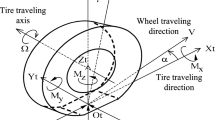Abstract
During many years of experiment, there have been used different tire models from purely experimental models with different approximation mathematical expressions, via physical models that take into account the important parameters of the tires and the tire contact patch, to FEM. However, these models can be inadequate for numerical simulations due to large CPU time consumption. In this paper, the Brush model and the proposed advanced Brush model is processed to define the forces of adhesion between the tire and the road, which is sufficiently simple and fast for simulations with sufficient accuracy. The advanced Brush model is defined by the most realistic contact pressure between the tire and the road which changes as a function of the force generated and the vertical load on the tire.
Access this chapter
Tax calculation will be finalised at checkout
Purchases are for personal use only
Similar content being viewed by others
References
Raymond, M., Brach, R.: Matthew brach: tire models for vehicle dynamic simulation and accident reconstruction. SAE, 1–2 (2009). ISSN 0148–7191
Pacejka, H.: Tyre and Vehicle Dynamics, Elsevier, 3rd edn. ,59–202 (2012). ISBN-13: 978–0–08-097016-5
Lu, C.-Y., Shih, M.-C.: Application of the pacejka magic formula tyre model on a study of a hydraulic anti-lock braking system for a light motorcycle vehicle system dynamics. Int. J. Vehicle Mech. Mobility 41(6), 431–448 (2010). https://doi.org/10.1080/00423110512331383848
Schmeitz, A.J.C., Besselink, I.J.M., de Hoogh, J., Nijmeijer, H.: Extending the Magic Formula and SWIFT tyre models for inflation pressure changes. Researchgate, 1–3 (2005). ISSN 0083-5560
Pauwelussen, J.P., Gootjes, L., Schroder, C., Kohne, K.-U., Jansen, S., Schmeitz, A.: Full vehicle ABS braking using the SWIFT rigid ring tyre model. Control Eng. Practice 11(2) (2003). ISSN: 0967-0661:199-207
Uil, R.T.: Tyre models for steady-state vehicle handling analysis. Eindhoven University of Technology, DCT 2007(142), 11–36 (2007)
Sjahdanulirwan, M., Yang, Q.: Prediction of tyre-road friction with an inverted-boat shaped pressure distribution. Int. J. Vehicle Mech. Mobility 24, 145–161 (2007)
Deur, J., Ivanović, V., Troulis, M., Miano, C., Hrovat, D., Asgari, J.: Extensions of the LuGre tyre friction model related to variable slip speed along the contact patch length, Vehicle System Dynamics. Int. J. Veh. Mech. Mobility 43, 508–524 (2011). https://doi.org/10.1080/00423110500229808
Yamashita, H., Matsutani, Y., Sugiyama, H.: Longitudinal tire dynamics model for transient braking analysis: ANCF-LuGre tire model. J. Comput. Nonlinear Dyn. 10(3), 1–11 (2015). CND-14–1109
Velenis, E., Tsiotras, P., Canudas-de-Wit, C., Sorine, M.: Dynamic tyre friction models for combined longitudinal and lateral vehicle motion, Vehicle System Dynamics. Int. J. Veh. Mech. Mobility 43, 9–18 (2011). inria-00000921
Gipser, M.: FTire – the tire simulation model for all applications related to vehicle dynamics. Vehicle Syst. Dyn. Int. J. Veh. Mech. Mobility 45, 139–151 (2008) https://doi.org/10.1080/00423110801899960
Tonuk, E., Samim Unlusoy, Y.: Prediction of automobile tire cornerong force characteristics by finite element modeling and analysis. Comput. Struct. 79(13) (2001).https://doi.org/10.1016/S0045-7949(01)00022-0:1219-1232
Rajamani, R.: Vehicle dynamics and control, 2nd edn. Springer (2012). ISSN 0941-5122,355-396
Kiebre, R.: Contribution to the modelling of aircraft tyre-road interaction, Universit´e de Haute Alsace - Mulhouse, tel-00601774, p. 8–29 (2011)
Svendenius, J: Tire Modeling and Friction Estimation, Department of Automatic Control Lund University, pp. 39–66 (2007). ISSN 0280-5316
Jazar, R.: Vehicle Dynamics – Theory and Application, 1st edn., pp. 95–161. Springer (2008). ISBN 978-0-387-7424-3
Author information
Authors and Affiliations
Corresponding author
Editor information
Editors and Affiliations
Rights and permissions
Copyright information
© 2022 The Author(s), under exclusive license to Springer Nature Switzerland AG
About this paper
Cite this paper
Jelkić, Z., Pikula, B. (2022). The Establishment of an Advanced Brush Model for Simulation of Vehicle Dynamics. In: Karabegović, I., Kovačević, A., Mandžuka, S. (eds) New Technologies, Development and Application V. NT 2022. Lecture Notes in Networks and Systems, vol 472. Springer, Cham. https://doi.org/10.1007/978-3-031-05230-9_30
Download citation
DOI: https://doi.org/10.1007/978-3-031-05230-9_30
Published:
Publisher Name: Springer, Cham
Print ISBN: 978-3-031-05229-3
Online ISBN: 978-3-031-05230-9
eBook Packages: Intelligent Technologies and RoboticsIntelligent Technologies and Robotics (R0)




